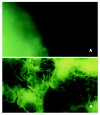Gene transfer and expression of enhanced green fluorescent protein in variant HT-29c cells
- PMID: 12970911
- PMCID: PMC4656679
- DOI: 10.3748/wjg.v9.i9.2083
Gene transfer and expression of enhanced green fluorescent protein in variant HT-29c cells
Abstract
Aim: To study the expression of enhanced green fluorescent protein (EGFP) gene in retrovirally transduced variant HT-29 cells.
Methods: The retroviral vector prkat EGFP/neo was constructed and transfected into the 293T cell using a standard calcium phosphate precipitation method. HT-29c cells (selected from HT-29 cells) were transduced by a retroviral vector encoding the GEFP gene. The fluorescence intensity of colorectal carcinoma HT-29c cells after transduced with the EGFP bearing retrovirus was visualized using fluorescence microscope and fluorescence activated cell sorter (FACS) analysis. Multiple biological behaviors of transduced cells such as the proliferating potential and the expression of various antigens were comparatively analyzed between untransduced and transduced cells in vitro. EGFP expression of the fresh tumor tissue was assessed in vivo.
Results: After transduced, HT-29c cells displayed a stable and long-term EGFP expression under the nonselective conditions in vitro. After cells were successively cultured to passage 50 in vitro, EGFP expression was still at a high level. Their biological behaviors, such as expression of tumor antigens, proliferation rate and aggregation capability were not different compared to untransduced parental cells in vitro. In subcutaneous tumors, EGFP was stable and highly expressed.
Conclusion: An EGFP expressing retroviral vector was used to transduce HT-29c cells. The transduced cells show a stable and long-term EGFP expression in vitro and in vivo. These cells with EGFP are a valuable tool for in vivo research of tumor metastatic spread.
Figures



Similar articles
-
[Expression of enhanced green fluorescent protein in transduced variant HT-29c cells in vitro and in vivo].Zhonghua Wai Ke Za Zhi. 2002 May;40(5):372-4. Zhonghua Wai Ke Za Zhi. 2002. PMID: 12133346 Chinese.
-
Enhanced green fluorescent protein as selectable marker of retroviral-mediated gene transfer in immature hematopoietic bone marrow cells.Blood. 1997 Nov 1;90(9):3304-15. Blood. 1997. PMID: 9345012
-
Quantitative evaluation of the murine B16 melanoma tumor model after gene marking with an EGFP/Neo expressing retroviral vector.In Vivo. 2002 May-Jun;16(3):167-74. In Vivo. 2002. PMID: 12182111
-
Increased probability of expression from modified retroviral vectors in embryonal stem cells and embryonal carcinoma cells.J Virol. 1997 Dec;71(12):9466-74. doi: 10.1128/JVI.71.12.9466-9474.1997. J Virol. 1997. PMID: 9371608 Free PMC article.
-
Gene transfer in ovarian cancer cells: a comparison between retroviral and lentiviral vectors.Cancer Res. 2002 Nov 1;62(21):6099-107. Cancer Res. 2002. PMID: 12414634
References
-
- Prasher DC, Eckenrode VK, Ward WW, Prendergast FG, Cormier MJ. Primary structure of the Aequorea victoria green-fluorescent protein. Gene. 1992;111:229–233. - PubMed
-
- Chalfie M, Tu Y, Euskirchen G, Ward WW, Prasher DC. Green fluorescent protein as a marker for gene expression. Science. 1994;263:802–805. - PubMed
-
- Cubitt AB, Heim R, Adams SR, Boyd AE, Gross LA, Tsien RY. Understanding, improving and using green fluorescent proteins. Trends Biochem Sci. 1995;20:448–455. - PubMed
-
- Stearns T. Green fluorescent protein. The green revolution. Curr Biol. 1995;5:262–264. - PubMed
-
- Heim R, Cubitt AB, Tsien RY. Improved green fluorescence. Nature. 1995;373:663–664. - PubMed
Publication types
MeSH terms
Substances
LinkOut - more resources
Full Text Sources

